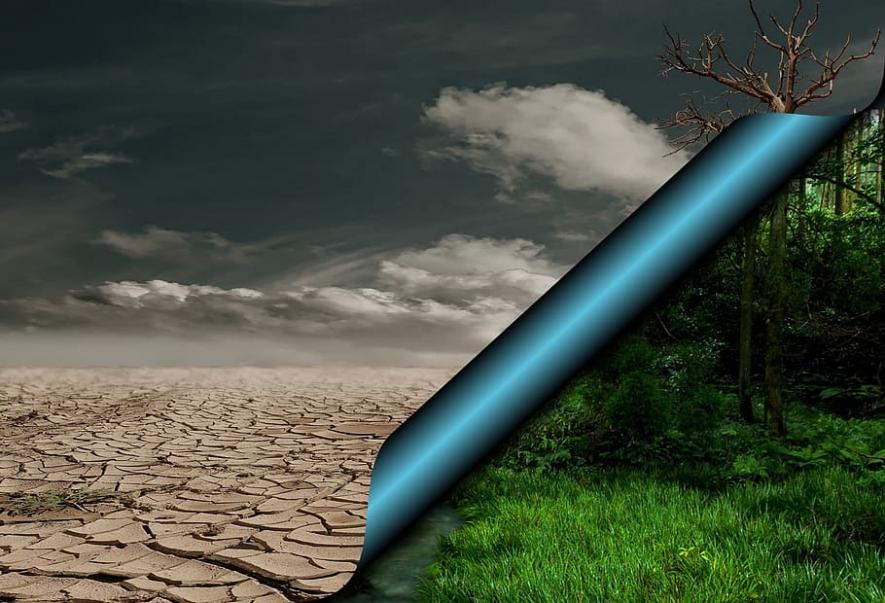IPCC Report: The World’s Standing on a Burning Deck

Image Courtesy: Wallpaper Flare
Earlier this week, the Intergovernmental Panel on Climate Change (IPCC), the leading international scientific body on climate change working under the aegis of the United Nations, released its latest report from Interlaken, Switzerland. This is not a fresh report based on new findings, but a Synthesis Report of the three volumes of the IPCC’s Sixth Assessment Report (IPCC/AR6) which were released at different times during the previous year.
As is the usual IPCC practice, these three volumes of IPCC/AR6 deal with the science of climate change, the impacts, vulnerabilities and potential adaptation strategies, and finally the possible strategies for mitigation i.e. reduction of greenhouse gas (GHG) emissions that cause climate change.
The Synthesis Report puts the major findings of these three reports together, looks at them in an integrated manner and explores their inter-relationship toward a holistic approach to tackle climate change.
The present report is not even the full Synthesis Report of IPCC/AR6, which will be released later in the year, but a Summary for Policy Makers (SPM) of the fuller report which, nevertheless, puts forward the most important evidence, conclusions and recommendations of IPCC/AR6 so as to guide policy makers at international and especially at national levels in formulating and implementing climate action.
This report gains significance due to the fact that it is the last in the roughly seven-year assessment cycles of IPCC during this decade, even though there may well be different special reports or studies between now and 2030. It is also important because it has been signed-off on by all governments.
Since it is the definitive scientific assessment of this decade, it focuses our attention, and those of governments and other actors around the world, on where the world and different nations stand vis-à-vis climate change, what impacts we can expect given the current and foreseeable trajectory of emissions of carbon dioxide (CO2) and other GHGs, and what needs to be done to avert, or at least ameliorate, the disastrous consequences facing us.
Understanding climate change today
Global average surface temperature is now 1.1 degree C higher than it was in 1850-1900, which is hardly a surprise since around 42% of cumulative emissions have been emitted just in the past century or more during 1900-2019. Further, global net emissions (i.e. total emissions less emissions absorbed by sinks in forests and oceans) in 2019 continued to rise and remained at a record high at 59 GtCO2-eq (1 gigaton GHGs = equivalent of 1 billion tonnes of carbon dioxide), which is 12% higher than in 2010 and 49% higher than in 1990.
It may be recalled that the previous climate change control agreement, the Kyoto Protocol, had required global emissions to be 5% less than 1990 levels by 2008-12. Exposing the utter inadequacy of emission control measures and adherence to them especially by developed countries, emissions during the period 2010-19 were higher than any previous decade on record.
The only thin silver lining has been that, finally, the rate of growth of emissions during 2010-19 at 1.3%/year, including after implementation of the National Determined Contributions (NDC) under the Paris Agreement, has been lower than in the previous decade of 2000-2009 at 2.1%/year. What happens in the current decade, especially given the war in Ukraine, the diversion of fund flows by the Western nations to military actions related to that conflict, and the revival and growth of fossil-fuel energy including coal and natural gas in the West, is a moot question.
Even without such sudden events, global warming is expected to increase steadily during 2020-40 due mainly to cumulative emissions and the “climate lag” even if emissions are slowed down, with temperature rise “more likely than not” to reach 1.5C even under low-emissions scenarios and “very likely” to cross 1.5C at higher emissions scenarios.
Growing or even irreversible impacts
The changes in climate in different regions of the world have become increasingly visible and, with every increase in emissions and global average temperature, are worsening faster than earlier predicted. Climate extremes have been observed in heat waves, droughts, resulting forest fires, extreme rainfall or other precipitation, tropical cyclones.
The report points out that vulnerable people, who have contributed the least to factors causing climate change, are suffering the most, with an estimated 3.3-3.6 billion people living in areas facing droughts, water and food shortages, and extreme weather. Extreme heat events are leading to increased morbidity and mortality, increase in vector-, food- or water-borne diseases, and increased displacement, especially in small islands and already vulnerable deltaic regions like the Sunderbans.
If such impacts are already occurring at a temperature rise of 1.1C, the situation at the now-targeted 1.5C, or the earlier targeted 2C, can only be imagined. The report states that while some changes may be rolled back if temperature rise is arrested or reversed by 2050, many of these changes in climate will be long-lasting or even permanent. The report further emphasises that these changes and impacts will worsen with each increment in global warming.
The report highlights an even more worrying trend. Some climate impacts, especially those with long gestation periods, have already or are rapidly approaching irreversible changes. Ocean acidification and temperature change may also precipitate mass species extinction events and other biodiversity loss, signs of which are already visible. Depleting fish stocks, worsened by overfishing, already threaten food security in large parts of the world.
Sea-level rise, for instance, which is increasing and at accelerating rates, is expected to continue over hundreds or even thousands of years to come due to expansion of oceans and polar ice-sheet melts, although the acceleration rates may be reduced with sharp and sustained reduction emissions. Therefore, coastal regions are expected to be highly vulnerable in the coming years, whatever emissions reductions are achieved. At higher temperatures beyond 2C, western Arctic and Greenland ice sheets are likely to be lost forever.
Mitigation efforts
The report underlines that whereas several countries have reduced both production and consumption-based emissions over many years, and others too have slowed emissions growth, these have been insufficient to overcome the overall increase in emissions. Current emissions trajectories, even after adoption of enhancements in NDCs at COP26 in Glasgow, are woefully inadequate.
At current rates, there is a large emissions gap between emission cuts announced till 2030 and emission levels required for 1.5C. With present trajectories, temperature rise is expected to reach 2.8C. The implementation gap has also to be reckoned with, where countries do not achieved their pledged targets, as has happened often over the history of emissions control efforts. Temperature rise could then touch 3.2C! This can be prevented ONLY by immediate action and steep emission cuts by 2030.
The report tellingly observes that while many countries have announced “net zero” emissions by 2050, these promises lack specifics and are not supported by extant or projected policies. In other words, they are grandiose but empty promises. Same with financial flows from developed to developing countries, which are far less than the promised $100 billion per year. In fact, the report points out, finance flows for fossil-fuel industries continue to be higher than for mitigation or adaptation!
The road ahead
It is clear from the report that the world is not adequately tackling the real and critical problems of climate change. Successive IPCC and other reports have repeatedly and with growing certainty highlighted the dangers humanity, especially the vulnerable populations, are facing and what needs to be done to overcome them. Yet the sharp emissions reductions required, especially by developed countries, are nowhere to be seen. It is as if the alarm keeps ringing “Fire” but nobody tries to put it out. Vested interests of the fossil fuel industries and global capitalism in general prevent meaningful action by most countries of the global North. Geopolitics and great power rivalry perhaps stand in China’s way.
Unless COP28 and the next few COPs find their way to set in place steep emission cuts, especially by developed countries, but also by all countries, including large developing countries with economic and technological capabilities, nothing can stop the climate juggernaut.
Meanwhile, climate change is itself accelerating deeper changes. Impacts on the polar regions, ice sheets and glaciers, and the oceans drive further changes in climate due to changes in ocean currents, evaporation rates and precipitation patterns, cyclones and storms.
The report also points out that the capacity of forests and oceans to absorb carbon dioxide emissions is decreasing with global warming, therefore, the effect of rising emissions is worsening more rapidly. Climate impacts are reaching levels where the ability of ecosystems to adapt to changes may reach its limits in several aspects. This would lead to cascading impacts where effects in one sector accelerate effects in another, adding on to pre-existing structural vulnerabilities of sections of the population.
The important recommendation of the Synthesis Report is, therefore, that mitigation and adaptation policies should not be conceptualised in a sectoral manner but as an integrated, multi-sectoral climate resilient developmental effort. The world is even farther away from this goal than from even sector-specific emissions reduction. India has at least started to address mitigation in some sectors, but has not even begun to look at adaptation, even while climate impacts ravage the country.
The writer is with the Delhi Science Forum and All India People’s Science Network. The views are personal.
Get the latest reports & analysis with people's perspective on Protests, movements & deep analytical videos, discussions of the current affairs in your Telegram app. Subscribe to NewsClick's Telegram channel & get Real-Time updates on stories, as they get published on our website.
























